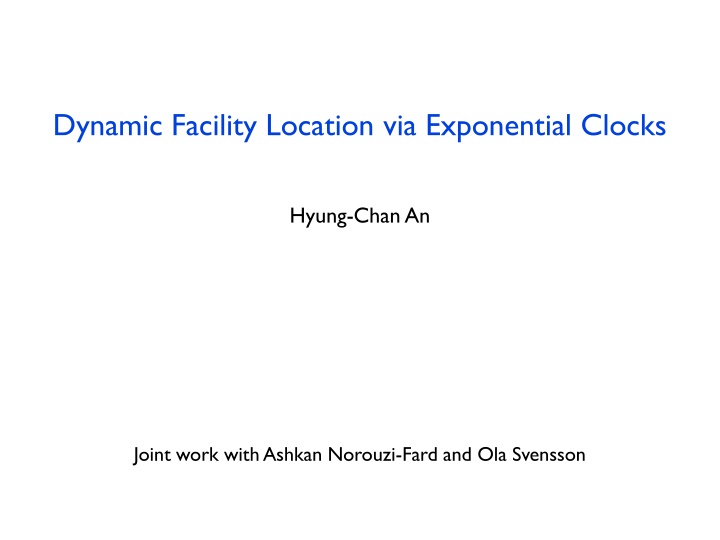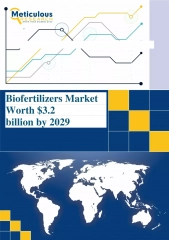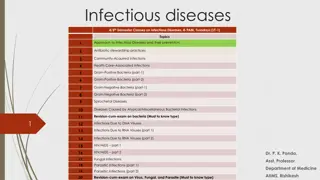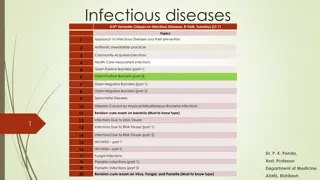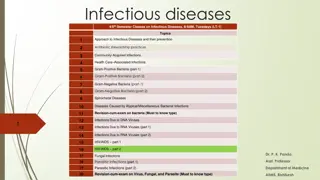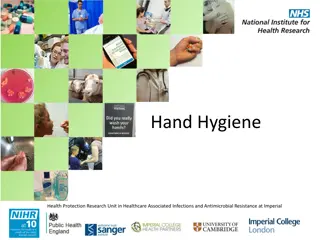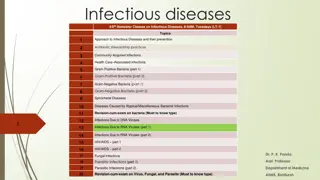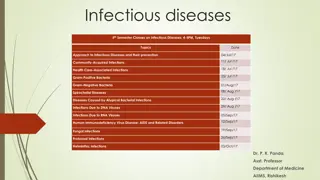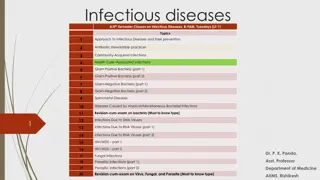Harmful Microbes and Infectious Diseases
Learn about harmful microbes and infectious diseases, understanding how they can make us ill, spread, and cause infections. Discover different types of infectious diseases and discuss their characteristics in a group setting.
Download Presentation

Please find below an Image/Link to download the presentation.
The content on the website is provided AS IS for your information and personal use only. It may not be sold, licensed, or shared on other websites without obtaining consent from the author.If you encounter any issues during the download, it is possible that the publisher has removed the file from their server.
You are allowed to download the files provided on this website for personal or commercial use, subject to the condition that they are used lawfully. All files are the property of their respective owners.
The content on the website is provided AS IS for your information and personal use only. It may not be sold, licensed, or shared on other websites without obtaining consent from the author.
E N D
Presentation Transcript
Dynamic Facility Location via Exponential Clocks Hyung-Chan An July 29, 2013 Joint work with Ashkan Norouzi-Fard and Ola Svensson
Classical facility location problem Given a metric cost c on D: set of clients F: set of facilities 6 2 1 5
Classical facility location problem Given a metric cost c on D: set of clients F: set of facilities oi: opening cost of i F 5 100 1
Classical facility location problem Given a metric cost c on D: set of clients F: set of facilities oi: opening cost of i F 5 100 Want: Choose S F to open Assign every client to an open facility f : D S 1
Classical facility location problem Given a metric cost c on D: set of clients F: set of facilities oi: opening cost of i F 2 2 5 2 100 5 Want: Choose S F to open Assign every client to an open facility f : D S 3 2 1 Minimize i S oi + j D cj,f(j) = (1 + 5) + (2 + 2 + 2 + 5 + 2 + 3)
Dynamic facility location problem [Eisenstat et al. 2014] Dynamics of evolving social/infrastructure networks Given a metric cost c1, ,cT on D: set of clients F: set of facilities oi: opening cost of i F For each timestep t: Choose St F to open Assign every client to an open facility ft: D St Stable solution Switching cost g every time a client changes its assignment
Dynamic facility location problem Example [Eisenstat et al. 2014] Task: given geographical locations of people, identify groups
Dynamic facility location problem Example [Eisenstat et al. 2014] Task: given geographical locations of people, identify groups 1
Dynamic facility location problem Example [Eisenstat et al. 2014] Task: given geographical locations of people, identify groups Set F as D, with uniform opening cost of 1
Dynamic facility location problem Example [Eisenstat et al. 2014] Task: given geographical locations of people, identify groups cost 2+ Set F as D, with uniform opening cost of 1
Dynamic facility location problem Example [Eisenstat et al. 2014] Task: given geographical locations of people, identify groups c1
Dynamic facility location problem Example [Eisenstat et al. 2014] Task: given geographical locations of people, identify groups c1 c2
Dynamic facility location problem Example [Eisenstat et al. 2014] Task: given geographical locations of people, identify groups c1 c2 c3
Dynamic facility location problem Example [Eisenstat et al. 2014] Task: given geographical locations of people, identify groups c1 c2 c3 cost 5+ (+8g) Switching cost: g = 0
Dynamic facility location problem Example [Eisenstat et al. 2014] Task: given geographical locations of people, identify groups c1 c2 c3 cost 6+ Switching cost: g = 100
Dynamic facility location problem O(log(nT))-approximation algorithm [Eisenstat et al. 2014] Does not use triangle inequality Can we use triangle inequality to get better approximation?
Main result Theorem There exists an LP-rounding O(1)-approximation algorithm for dynamic facility location
Introduction Algorithm
Standard LP (for classical) Variables i F i F, j D xij=1 if j is assigned to i, 0 if not yi=1 if open, 0 if not Minimize subject to i F oiyi + i F, j D cijxij xij yi i F xij 1 x, y 0 i F, j D j D
Standard LP (for dynamic) Variables for timestep t i F i F, j D xij=1 if j is assigned to i, 0 if not yi=1 if open, 0 if not t t Minimize subject to t ( i F oiyi + i F, j D cijxij) + g/2 t ||xt+1-xt||1 xij yi i F xij 1 x, y 0 t t i F, j D, t [T] j D, t [T] t t t
Standard LP (for classical) Our algorithm rounds each timestep separately Can focus on the classical LP Minimize subject to i F oiyi + i F, j D cijxij xij yi i F xij 1 x, y 0 i F, j D j D
Representing an LP solution Simplifying assumption Rational solution with common denominator M xij {0, 1 ? ?}, yi = 1
Representing an LP solution Simplifying assumption Rational solution with common denominator M xij {0, 1 ? ?}, yi = 1 LP solution can be represented as an unweighted graph 1/4 3/4 2/4 0/4 2/4 3/4 2/4 1/4
[Shmoys et al. 1997] [Chudak & Shmoys 2003] [Byrka & Aardal 2010] Previous LP-rounding algorithms If each facility is opened w. p. 1/M, and each client j is connected via an edge (j, i) w. p. 1/M, done!
[Shmoys et al. 1997] [Chudak & Shmoys 2003] [Byrka & Aardal 2010] Previous LP-rounding algorithms If each facility is opened w. p. 1/M, and each client j is connected via an edge (j, i) w. p. 1/M, done! Clusters of M facilities, centered at clients
[Shmoys et al. 1997] [Chudak & Shmoys 2003] [Byrka & Aardal 2010] Previous LP-rounding algorithms If each facility is opened w. p. 1/M, and each client j is connected via an edge (j, i) w. p. 1/M, done! Clusters of M facilities, centered at clients Open exactly 1 facility in each cluster
[Shmoys et al. 1997] [Chudak & Shmoys 2003] [Byrka & Aardal 2010] Previous LP-rounding algorithms If each facility is opened w. p. 1/M, and each client j is connected via an edge (j, i) w. p. 1/M, done! Clusters of M facilities, centered at clients Open exactly 1 facility in each cluster
[Shmoys et al. 1997] [Chudak & Shmoys 2003] [Byrka & Aardal 2010] Previous LP-rounding algorithms If each facility is opened w. p. 1/M, and each client j is connected via an edge (j, i) w. p. 1/M, done! Clusters of M facilities, centered at clients Open exactly 1 facility in each cluster Fallback path of length 3 guaranteed
Question Can we use longer paths? Yes. Our algorithm uses arbitrarily long paths. Can we do without clustering? Clustering is sensitive to small change in x Yes. Our algorithm does not use clustering.
Our algorithm Sample i.i.d. clocks on each node from Exp(1) .83 .50 .75 .70 .78 .73 .81 .82 .90 .72 .84 .79 .91 .85 .88 .71
Our algorithm Sample i.i.d. clocks on each node from Exp(1) Each node chooses a node with the smallest clock in its neighborhood .83 .50 .75 .70 .78 .73 .81 .82 .90 .72 .84 .79 .91 .85 .88 .71
Our algorithm Sample i.i.d. clocks on each node from Exp(1) Each node chooses a node with the smallest clock connection graph GC
Our algorithm Sample i.i.d. clocks on each node from Exp(1) Each node chooses a node with the smallest clock connection graph GC Open every facility on cycles
Our algorithm Sample i.i.d. clocks on each node from Exp(1) Each node chooses a node with the smallest clock connection graph GC Open every facility on cycles Connect each client by following the uniquely defined connection path
Our algorithm Sample i.i.d. clocks on each node from Exp(1) Each node chooses a node with the smallest clock connection graph GC Open every facility on cycles Connect each client by following the uniquely defined connection path Suffices to bound the length of connection paths
Analysis Easy to show that every facility is opened w. p. 1/M Focus on connection cost
Analysis When will j1 s connection path starts with these six arcs? i2 i1 j2 j3 j1 i3 j4
Analysis When will j1 s connection path starts with these six arcs? i1 has the smallest clock in j1 s neighbor j2 has the smallest clock in i1 s neighbor i2 has the smallest clock in j2 s neighbor i2 i1 j2 j3 j1 i3 j4 :
Analysis When will j1 s connection path starts with these six arcs? i1 has the smallest clock in j1 s neighbor j2 has the smallest clock in i1 s neighbor i2 has the smallest clock in j2 s neighbor i2 i1 j2 j3 j1 i3 j4 :
Analysis When will j1 s connection path starts with these six arcs? i1 has the smallest clock in j1 s neighbor j2 has the smallest clock in i1 s neighbor i2 has the smallest clock in j2 s neighbor i2 i1 j2 j3 j1 i3 j4 :
Analysis When will j1 s connection path starts with these six arcs? i1 has the smallest clock in j1 s neighbor j2 has the smallest clock in i1 s neighbor i2 has the smallest clock in {j1, j2} s neighbor i2 i1 j2 j3 j1 i3 j4 :
Analysis When will j1 s connection path starts with these six arcs? i1 has the smallest clock in j1 s neighbor j2 has the smallest clock in i1 s neighbor i2 has the smallest clock in {j1, j2} s neighbor j3 has the smallest clock in {i1, i2} s neighbor i3 has the smallest clock in {j1, j2, j3} s neighbor j4 has the smallest clock in {i1, i2, i3} s neighbor i2 i1 j2 j3 j1 i3 j4
Analysis Probability rapidly decreases as we consider longer paths! For each e, Consider all possible paths in the connection graph containing e, sum their probabilities
Analysis In fact, any given edge is used as the 1stedge of 1/M connection paths, the 2ndedge of 1/M connection paths, the 3rdedge of 1/M connection paths, the 4thedge of 1/M connection paths, the 5thedge of 1/2M connection paths, the 6thedge of 1/2M connection paths, the 7thedge of 1/4M connection paths, the 8thedge of 1/4M connection paths in expectation. 1 ?+ 1 ?+ 1 1 1 1 6 ? 2?+ 2?+ 4?+ 4?+ =
Analysis 1-approximation for opening cost 6-approximation for connection cost Lagrangian-preserving 6-approximation for classical facility location
Analysis Switching cost Two solutions differ only in j s connection variables j j
Analysis Switching cost Two solutions differ only in j s connection variables Can this affect the connection path of client j ? j j j j In expectation, affects 7 connection paths
Analysis 1-approximation for opening cost 6-approximation for connection cost 14-approximation for switching cost Theorem There exists a 14-approximation algorithm for dynamic facility location
